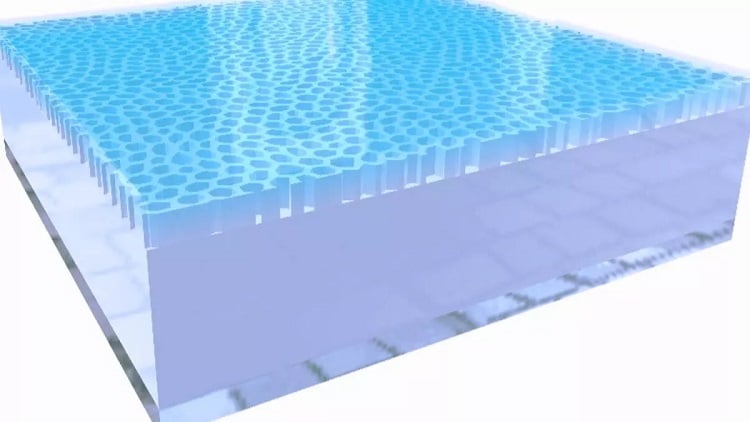S. Himmelstein | June 20, 2022
 The thin silicon membrane features a disordered honeycomb layer to maximize light absorption. Source: University of Surrey
The thin silicon membrane features a disordered honeycomb layer to maximize light absorption. Source: University of Surrey
Use of thin membranes instead of the thick, rigid wafers in silicon (Si) solar cells can reduce the amount of Si needed by more than 99% and result in flexible, lightweight photovoltaic devices that can be easily integrated into buildings and personal electronics. A major challenge in slimming down solar cells is that thin Si membranes cannot absorb light as efficiently. By rendering thin cells opaque, researchers from the University of Surrey (U.K.), Imperial College London and Research Institute AMOLF (Netherlands) have discovered a way to achieve both high solar conversion efficiency and 1 μm-thick cells.
The patterned nanostructure applied to a small area of the cell’s surface re-directs straight sunlight into a range of angles, thereby trapping light inside the Si membrane. Trapping the light increases its absorption: the hyperuniform pattern guides light into very specific angles that are trapped into the membrane based on the periodicity of the pattern.
Laboratory measurements confirm that such textured thin membranes absorb 65% of sunlight, which is very close to the ultimate theoretical absorption limit of ~70%. An efficiency of 21% was documented along with an absorption rate of 26.3 mA/cm2, a 25% increase on the previous record of 19.72 mA/cm2 achieved in 2017. This is the highest light absorption ever demonstrated in such a thin Si membrane and it is, therefore, likely that flexible, light-weight and efficient Si photovoltaic cells will be developed in the near future.
As thinner Si absorbers are more tolerant to electronic defects compared to their thick counterparts, highly efficient thin cells could be fabricated with lower grade Si, thereby reducing the energy needs for raw Si purification and reducing their energy pay-back time.
The research can be accessed in ACS Photonics.
